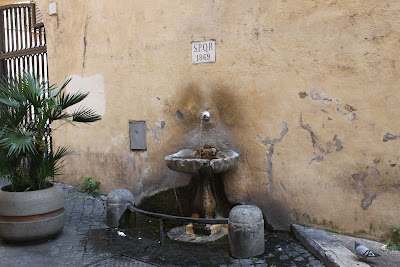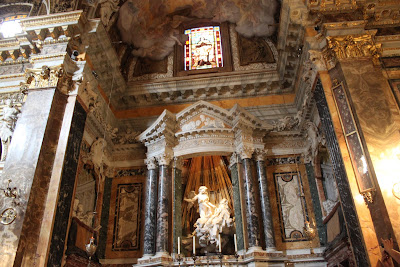I checked my notes and see that our first lunch in Rome included maccheroni ammatriciana for Bill (large tubular noodles in a tomato, pancetta, and pecorino sauce) and a pizza capricciosa for me (with mushrooms, artichokes, olives, and prosciutto). I know my foodie friends need details such as this.

After lunch we returned to the hotel for maps and my cameras and headed out for our walk (partly described in the previous post). Here is a view looking down Via della Purificazione toward the Piazza Barberini.

For those of you who did not take Latin in high school or study Roman history, SPQR stands for Senatus Populusque Romanus (the Senate and the Roman People). You have seen it in many a bathrobe drama, often on the standards of Roman soldiers. It is still used today as you can see here.

The Roman aqueducts not only brought water to the city in ancient times, they still power the great fountains and the ubuquitous little fountains on streets everywhere. Here is one we passed every day.

Those who recall my photos of New Orleans know that I love architectural details. Check out the grill work above this door.

The door is located on the Via delle Quattro Fontane opposite the Palazzo Barberini (below). Here you see the statuary and gates.

This is the palazzo proper. It is the National Gallery of Classical Art (I take liberty translating Arte Antica as Classical Art because "antique" sounds odd in English here).

Maffei Barberini became Pope Urban VIII and had a palace built. One of the architects was Bernini. Below is the entrance loggia.

The stairs leading up toward the gardens:

The staircase:
 From the museum website I have snaffled some samples for you:
From the museum website I have snaffled some samples for you:Titian's Venus and Adonis (post 1553)

Andrea del Sarto's Sacra Famiglia (1528-29)

Hans Holbein's Henry VIII (1540)

Raphael's La Fornarina (1520). She was his mistress, though there is some question whether this work was by his hand.

We had visited the museum while waiting for Santa Maria della Vittoria to open. Inside the church I prayed and this was my Palm Sunday worship. If you read this blog, you were prayed for.

The church was begun in 1605 as a chapel dedicated to Saint Paul for the Discalced Carmelites. After the Catholic victory at the battle of White Mountain in 1620, which reversed the Reformation in Bohemia, the church was rededicated to the Virgin Mary. Turkish standards captured at the 1683 siege of Vienna hang in the church, as part of this theme of victory.
The order itself funded the building work until the discovery in the excavations of the Borghese Hermaphroditus. Scipione Borghese, nephew of Pope Paul V, appropriated this sculpture but in return funded the rest of work on the facade and granted the order his architect Giovanni Battista Soria. These grants only came into effect in 1624, and work was completed two years later. [Wikipedia]
Here is a ceiling shot I managed to get.

The fame of this church lies in a Bernini masterpiece. In the Cornaro Chapel, to the left of the high altar, may be found St Teresa in Ecstasy.
The statues depict a moment described by Saint Teresa of Avila in her autobiography, where she had the vivid vision of an angel piercing her heart with a golden shaft, causing her both immense joy and pain. The flowing robes and contorted posture abandon classical restraint and repose to depict a more passionate, almost voluptuous trance. [Wikipedia]My close-ups did not come out well so I share one shot from a distance for the dramatic context.

Here is a photo I took from the web:

From there we headed down to the Piazza della Repubblica and sat our weary selves down to enjoy some gelato and water. Then we visited le Terme di Diocleziano (The Baths of Diocletian), now divided between the church of Santa Maria degli Angeli and one of the sites of the Rome National Museum. The baths were built in 306 AD and Michelangelo redesigned the church in 1563, though 18th century remodeling changed it greatly. The scale is stunning.

A colossal statue named Meditation:

The oculus:

We had a serious nap after all this, then went to dinner at Ristorante Crispi 19. We had a bottle of Lacrima del Morro, from the Marches, and a bottle of Pellegrino. Bill dined on Amberjack tuna on a bed of mushrooms and tomatoes with a topping like shredded filo dough for crunch. Spread around this were two sauces: one a basil oil and the other tuna-based. I had a medallion of beef with a crisped polenta topping and a "lasagne" of potatoes, paired with spinach, and basil oil and a potato "sauce." I will quote from journal on dessert.
For dolci Bill had a layer of finely chopped cooked apples with a slightly nut flavored mousse, pistacchio gelato [using the Italian spelling here] and a caramel chocolate sauce. I had a "chocolate lava cake" with gelato on a crisped candied thin slice of Seville orange (awesome!).
After dinner we walked to la Trinità dei Monti, down the Scalinata (the Spanish Steps) and from the Piazza di Spagna back to the hotel "by way of the Inquisition."
Here is a view from the top of the Spanish Steps at night.

And here is the City College of the Propagation of the Faith. (Sent a chill down my spine, I tell you. Like walking past KGB offices in Russia.)

By the time we got back and I finished writing up the day it was 10 PM local time and bedtime.
By now y'all know why we came home tired. This was day one.
--the BB
